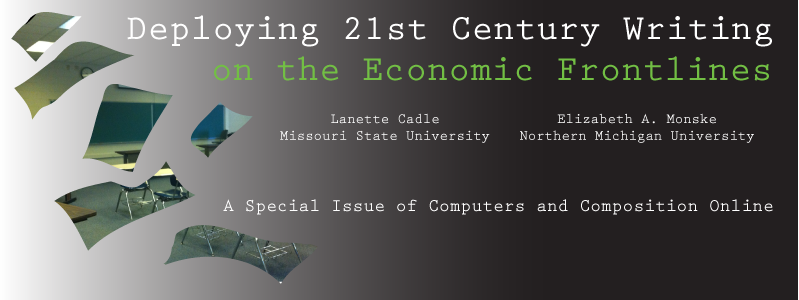C&C Online Special Issue—Spring 2013
An Introduction from the Editors
This joint special issue of Computers and Composition Online with Computers and Composition examines the disconnect between theory and reality for techno-rhetors moving from technology-rich graduate training to the less-than ideal setting normal for most new instructors. These are interesting times, and funding for education does not appear to look rosier in the future, a prediction most unfortunate. Rather than surrender to the economic stress about how much more must now be done with less, the editors for this special issue chose to accentuate the positive, which is the infinite intelligence and flexibility of the Computers and Writing community in dealing with hard times.
The idea behind this theme began as conversations between two new tenure-track professors about the disparity between the possibilities shown through a technology-rich graduate education in rhetoric and composition and the reality of teaching 21st century literacies without computers, needed software, or sometimes both. For both, it was a matter of limited resources. Through conversations with other Computers and Writing colleagues, we found that our situations are far from unique and others agree. Join us in celebrating their ideas for 21st century composition when the funds for technology are not forthcoming, and through this special issue, listen in while they share their strategies as well. We are pleased to also offer several multimodal expansions to articles featured in the print issue.
Theory Into Practice
Our Theory Into Practice begins with a contributor to our print edition, Stephanie Vie’s “Turn It Down, Don’t Turnitin: Resisting Plagiarism Detection Service by Talking About Plagiarism Rhetorically” argues for us to “critically examine [new digital composing spaces and technologies that automate writing instruction and assessment] in order to provide the highest levels of theoretically informed writing instruction that we can.” Offering some informed writing instruction, Craig A. Meyer in “Disability and Accessibility: Is there an app for that?” argues the “diversity of the student body and ongoing learning research suggests learning is more individualized than we may have previously realized” and offers the rationale and potential applications for us to take in the classroom. By also meeting students where they are, Courtney Patrick presents the theory and need for students to look at identity in “Perelman, Foucault, and Social Networking: How Facebook and Audience Perception Can Spark Critical Thinking in the Composition Classrooms.”
To meet with informed writing instruction, instructors need appropriate resources and support. In “Having the Right Stuff Is Only the Beginning: Technological and Institutional Challenges at the United State Military Academy”, Mike Edwards and Jeffrey S. Wilson discuss their initial restrictions, but present and offer their triumphs, as well as insights into acquisition and implementation of technology for others under institutional constraints. Christopher Sean Harris and Abraham Encinas address challenges of their own. “First Steps with ePortfolios on a Technology-Hesitant Campus” discusses their approach to create a pilot project that would “address needs identified by the ad hoc Educational Technology Committee: assessment and incorporating technology in the classroom” yet incorporate new technology.
Virtual Classroom
In the Virtual Classroom section, we offer three articles looking at classroom practice and approaches for technology and one article on how technology manifests in our learning spaces. First, Ken Gillam and Shannon Wooden provide a multimodal approach to their print article “Re-embodying Online Composition: Ecologies of Writing in Unreal Time and Space” which offers some best practices to online instruction. Similarly, Jeffrey Greene in “Bringing Hi-Tech Pedagogy to the Lo-Tech Classroom” also brings in some plans for best practices for incorporation of technology. As a best practice, John Killoran details his approach to using audio feedback in his composition courses in “Reel-to-Reel Tapes, Cassettes, and Digital Audio Media: Reverberations from a Half-Century of Recorded-Audio Response to Student Writing." Rounding out the Virtual Classroom section, we, editors Cadle and Monske, provide “A Writing Classroom Portrait” from multiple contributors, which displays images and quotes that showcase the many spaces instructors on the frontlines are using for student learning spaces.
Professional Development
The Professional Development section offers two webtexts. Caroline Dadas’ reflects on lessons learned from her transition to tenure line faculty member in “Confessions of a Technorhetorician," which offers a complement to Elizabeth Kleinfeld’s piece in the print issue. As an act of professional development, we also offer a “Digital Dictionary” from multiple contributors, edited by Jodi Lampi and William Barry, doctoral students from Texas State University – San Marcos. These contributors are graduate students who are navigating through the Computers and Writing discipline.
And... Some Thanks
We would like to sincerely thank all of the contributors for the print and online special editions of this collection for their patience and their speedy response to our hurried emails. We would also like to thank Cindy Selfe for encouraging us to submit the proposal for this special edition during the 2011 Computers and Writing conference. Finally, we would like to thank Kris Blair, our mentor, who prepared us for the frontlines and continues to champion the use of technology.
